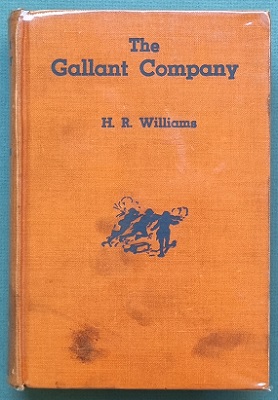Description
Title: The Gallant Company – an Australian soldier’s story of 1915 – 18 (56th Battalion)
Author: Williams, Harold Roy
Condition: Very Good +
Edition: 1st Edition
Publication Date: 1933
Cover: Hard Cover without Dust Jacket – 275 pages
Comments: An Australian soldier’s story of 1915-1918 which include some of the history of the 56th Battalion AIF.
With forward by Lieut- General Sir Talbot Hobbs KCB, KCMG, VD, General Officer Commanding, 5th Australian Infantry Division. Lieut-General Sir Talbot Hobbs, in his forward, says:
Mr William’s book is the best soldiers story I have read in Australia. It is written from within the battalion, of course, and yet is so general and so lifelike in fidelity to his scenes, that it would serve to illustrate and Australian infantryman’s story, wherever he served in France, his memories of life behind the lines and in England as well of experiences in action. The incidents are not exaggerated with regard to either the horrors of war or the magnificent gallantry, determination, and endurance of the Australian soldier. I fear that many Australian’s in their desire to forget the war, or their disgust perhaps, for some the so called war books that have been published, do not fully know or appreciate the part Australian soldiers played in that terrible struggle for freedom and humanity. Mr William’s story now gives them concise but most interesting readable form, a great deal of the war record of the AIF, and no true Australian can read it without his blood tingling with intense pride in the achievements , the endurance, and the reputation of his countrymen.
The 56th Battalion was raised in Egypt on 14 February 1916 as part of the “doubling” of the AIF. Half of its recruits were Gallipoli veterans from the 4th Battalion, and the other half, fresh reinforcements from Australia. Reflecting the composition of the 4th, the 56th was predominantly composed of men from New South Wales. The battalion became part of the 14th Brigade of the 5th Australian Division.
Arriving in France on 30 June 1916, the battalion entered the frontline trenches for the first time on 12 July and fought its first major battle at Fromelles a week later. The battle was a disaster, resulting in heavy casualties across the division. Despite these losses the 5th Division continued to man the front in the Fromelles sector for a further two months.
After a freezing winter manning trenches in the Somme Valley, in early 1917 the 56th Battalion participated in the advance that followed the German retreat to the Hindenburg Line. It was spared the assault but did, however, defend gains made during the second battle of Bullecourt. Later in the year, the AIF’s focus of operations switched to the Ypres sector in Belgium. The 56th’s major battle here was at Polygon Wood on 26 September.
With the collapse of Russia in October 1917, a major German offensive on the Western Front was expected in early 1918. This came in late March and the 5th Division moved to defend the sector around Corbie. The 14th Brigade, took up positions to the north of Villers-Bretonneux and held these even when the village fell, threatening their flanks.
Once the German offensive had been defeated, the Allies launched their own offensive in August 1918. The 14th Brigade did not play a major role in these operations until late in the month, but its actions were critical to the capture of Péronne, which fell on 2 September. The 56th fought its last major battle of the war, St Quentin Canal, between 29 September and 2 October 1918. It was resting out of the line when the Armistice was declared on 11 November. Soon after, members of the battalion began to be returned to Australia for discharge. It ceased to exist as a separate entity on 10 April 1919, when the remnants of all of the 14th Brigade’s battalions were merged into a single unit.




